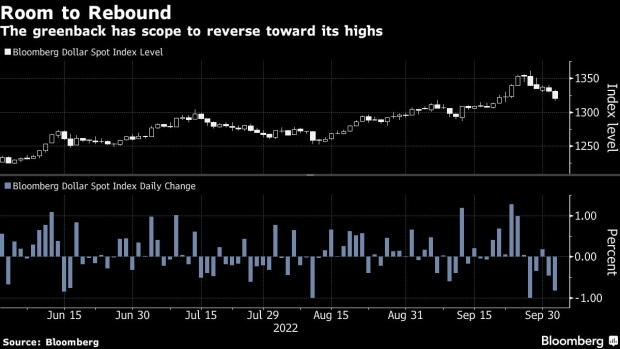Oct 4, 2022
Dollar to Shake off RBA’s ‘Wag the Dog’ Moment, Strategists Say
, Bloomberg News

(Bloomberg) -- The dip in the dollar, fueled by hopes of less aggressive monetary tightening from the world’s major central banks, may not last long.
Strategists from firms including Canadian Imperial Bank of Commerce and Brown Brothers Harriman are saying investors are profit taking on the rally that took the Bloomberg Spot Dollar Index to a record high last week, but that move will vanish soon. They expect the Federal Reserve and other central banks won’t follow the dovish steps of the Reserve Bank of Australia, which on Tuesday surprised markets with a smaller-than-expected rate hike.
“The dovish surprise from the RBA is a ‘wag the dog’ moment,” said Win Thin, head of currency strategy at Brown Brothers Harriman. “The Fed is nowhere near pivoting, and neither is the ECB. Nor the BOE.”
The Bloomberg dollar gauge has declined about 3% since reaching an all-time high last week as investors pared bets on a Fed pivot toward more aggressive rate hikes. Weaker-than-expected US economic data released this week reinforced the view that the nation’s central bank may not be as tough in its fight against inflation as many expected.
US Treasury yields tumbled this week, as traders have lowered their estimates of a peak policy Fed rate to 4.5% in March 2023, down from a recent peak at that same time of around 4.75%. Treasury yields have since trimmed much of their earlier gains that came following the RBA decision Tuesday morning, a move that was exacerbated by a drop in Australian yields, with the rate on three-year government bonds plunging by the most since 2008 following the rate hike.
But for some strategists, a hawkish Fed should remain the base-case scenario. Goldman Sachs Group Inc. said in a note to clients Tuesday Australia’s rate hike isn’t surprising given the regulator has been notably less hawkish, while Geoffrey Yu, a London-based senior strategist at Bank of New York Mellon Corp., argued Australia also functions within entirely different market parameters than the US Fed, which he said markets were neglecting to realize Tuesday.
“Don’t extrapolate too much from what the RBA did overnight,” said Yu in an interview on Bloomberg TV, adding he expects the Fed to raise rates at least 75 basis points at its next meeting in November. “That absolutely has to be the market base case.”
The Bloomberg dollar gauge has declined over the past two days against most of its Group-of-10 counterparts, erasing all its gains since Sept. 22 which included the dollar’s biggest quarter of increases since 2016 and record highs hit last week -- moves that were fueled by bets the Fed would continue raising interest rates to rein in inflation.
Technicals are favoring a dollar rebound. The Bloomberg dollar gauge is approaching 1,300, a key psychological level, which may attract bulls to buy the dip and reignite the dollar. Any further losses beyond that level, however, may encourage dollar bulls to back out of the trade.
“We were due for a take-profit move for the dollar,” said Bipan Rai, head of foreign-exchange strategy at Canadian Imperial Bank of Commerce. “It’s too early to say that the peak rates story is here to stay given lack of credible evidence on inflation.”
(Updates details throughout.)
©2022 Bloomberg L.P.





